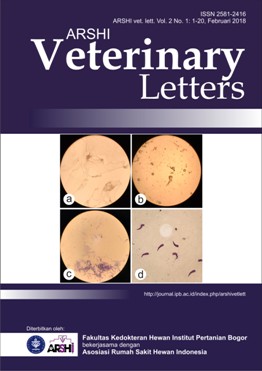Profil protein lambung tikus model ulkus peptikum hasil induksi aspirin dengan terapi ekstrak daun katuk (Sauropus androgynus)
Abstract
Ulkus peptikum dapat menyebabkan kerusakan jaringan yang menginduksi terjadinya perubahan profil protein berupa Heat Shock Proteins (HSPs). Penelitian ini memelajari efek antioksidan flavonoid daun katuk untuk pengobatan ulkus peptikum hasil induksi aspirin pada tikus. Tikus putih (Rattus norvegicus) sebanyak 20 ekor dibagi menjadi 5 kelompok perlakuan yaitu kontrol positif (ulkus peptikum), kontrol negatif, terapi P1 (8,1 mg/100 gram BB), terapi P2 (16,2 mg/100 gram BB), dan terapi P3 (24,3 mg/100 gram BB). Perlakuan diberikan selama 14 hari. Induksi ulkus peptikum dilakukan dengan pemberian aspirin 200 mg/kg BB selama 5 hari secara peroral. Isolasi protein lambung dan penentuan profil protein dilakukan dengan metode SDS-PAGE. Hasil penelitian menunjukkan bahwa protein yang muncul adalah HSP70, HSP60, HSP47, dan ubiquitin. HSP47dengan ukuran protein 47 kDa muncul pada kelompok P2 dan P3 sedemikian sehingga dapat diduga sebagai marker dalam proses kesembulan ulcer pada kasus ulkus peptikum.Downloads
References
Acarturk G, Senol A, Akin M, Sutcu R, Sahin O, Isler M. 2014. The protective effects of kefir in aspirin induced gastric muco-sal damage: an experimental study. Acta Medica Mediterranea. 30(4): 875-879.
Burkart V, H. Liu, K. Bellmann, D. Wissing, M. Jaattela, M. Cavallo. 2000. Natural resistance of human beta cells toward nitric oxide is mediated by heat shock protein 70. J Biol Chem 27 5:19521-528.
Cappello F, Everly C, Lorenzo M, Giovanni Z, and Alberto J. 2008. Hsp60 expression, new locations, functions, and perspectives for cancer diagnosis and therapy. Journal Cancer Biology and Therapy, 1555-8576.
Ciechanover A. 1994. The ubiquitine proteasome proteolytic path-way. Cell. 79:13-21
Fornai M, Antonioli L, Colucci R, Tuccori M, Blandizzi C. 2011. Pathophysiology of gastric ulcer development and healing: molecular mechanisms and novel therapeutic options. In Peptic Ulcer Disease. InTech.
Herrmann J, Lilach O, and Amir L. 2007. Ubiquitin and Ubiquitin-Like Proteins in Protein Regulation. Ahajournals; 100:1276-1291.
Ishida Y, Nagata K. 2011. 9 Hsp47 as a collagen-specific molecu-lar chaperone. Methods in enzymology. 499:167.
Nieto J. 2012. Diagnosing and treating gastric ulcers in horse. Center for equine health-the horses report.http://vetmed-ucdavis.edu
Parrah JD, Moulvi BA, Gazi MA, Makhdoomi DM, Athar H, Dar S, Mir AQ. 2013. Gastric ulceration in dog: a review. Vet world. 6(7): 449-454.
Stetler RA, Gan Y, Zhang W, Liou AK, Gao Y, Cao G, Chen J. 2010. Heat shock proteins: cellular and molecular mechanism in the CNS. Progress in neurobiology. 92(2): 184-211.
Torpy JM, Lynm C, Golub RM. 2012. Peptic ulcer disease. JAMA. 307(12):1329.
Tsukimi Y, Okabe S. 2001. Recent advances in gastrointestinal pathophysiology: role of heat shock proteins in mucosal de-fense and ulcer healing. Biological and Pharmaceutical Bulle-tin. 24(1):1-9.
Zuhra CF, Tarigan JB, Sihotang H. 2008. Aktivitas Antioksidan Senyawa Flavonoid dari Daun Katuk (Sauropus androgynus (L) Merr). Jurnal Biologi Sumatera. 3(1): 7-10.
Copyright (c) 2018 CC-BY-SA

This work is licensed under a Creative Commons Attribution-ShareAlike 4.0 International License.
Authors who publish with this journal agree to the following terms:
1. Authors retain copyright and grant the journal right of first publication with the work simultaneously licensed under a Creative Commons Attribution License that allows others to share the work with an acknowledgement of the work's authorship and initial publication in this journal.
2. Authors are able to enter into separate, additional contractual arrangements for the non-exclusive distribution of the journal's published version of the work (e.g., post it to an institutional repository or publish it in a book), with an acknowledgement of its initial publication in this journal.
3. Authors are permitted and encouraged to post their work online (e.g., in institutional repositories or on their website) prior to and during the submission process, as it can lead to productive exchanges, as well as earlier and greater citation of published work (See The Effect of Open Access).


.jpg)















